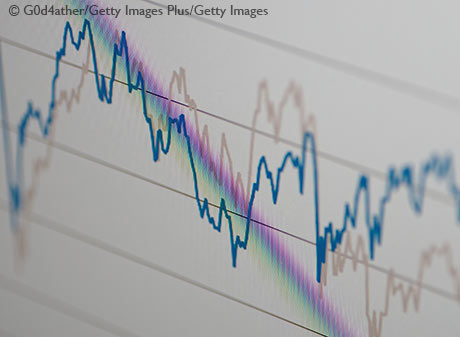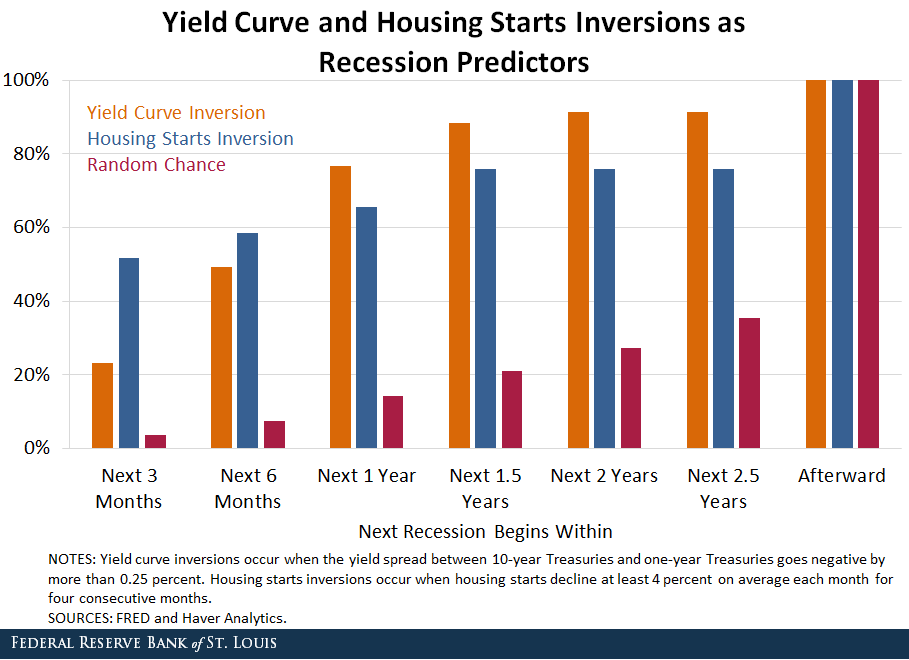Predicting Recessions: Which Signals Are More Accurate?

In deciding how concerned to be, however, it is useful to think about what a yield curve inversion really means and also consider other indicators of recessions. In this post, we will compare yield curve inversions against declines in housing starts (another suggested indicator) and see how well each performs at predicting recessions.
What Is a Yield Curve Inversion?
First, a bit more background: Investors lend money to the government for a fixed amount of time by buying bonds. They receive a yield, or payment, in return.
For this post, we’re defining the yield curve as the yield on 10-year Treasury notes minus the yield on one-year Treasury bills. Traditionally, yields on the 10-year notes are higher because the government must compensate investors accordingly for holding their money longer.
If investors thought a recession would occur next year, however, they may prefer to buy 10-year Treasuries even at lower yields to avoid receiving and reinvesting their money during a recession when market rates are falling.
When enough investors share this same opinion, the demand for 10-year Treasuries rises (allowing them to be sold at a lower yield), and demand for one-year Treasury bills falls (causing their yields to rise to attract investors). If the traditional relationship entirely reverses, and the yield is higher on one-year Treasuries than 10-year Treasuries, then this is referred to as a yield curve inversion.
Housing Starts and Recessions
To the extent that those investors are correct, inversions can serve as predictors of recessions. However, investors are not the only individuals who make predictions about the future of the economy. Similar predictions can be observed in every sector.
One sector that is particularly interesting is housing. When a recession is anticipated, people cut back on their spending, and one of the first purchases to be delayed is the new home. For this reason, if construction companies think that a recession is coming, they will start fewer new housing projects. Significant decreases in these “housing starts” for several months can be an indicator of a coming recession. (We refer to these as housing starts inversions.)
Comparing Yield Curve and Housing Starts Inversions
The figure below compares yield curve inversions and housing starts inversions as recession indicators. We look at how long after each such inversion it takes for the start of the next recession as defined by the National Bureau of Economic Research (NBER). For the inversions:
- We defined a yield curve inversion as occurring in a month when the yield spread goes negative by more than 0.25 percent.
- We defined a housing starts inversion as a decline in housing starts of at least 4 percent on average each month for four consecutive months.
The figure plots the chance that a recession will occur at various time intervals after each type of signal.

Notice that for both metrics, the chance that a recession will occur sometime in the future is 100 percent. This is not a victory, however. There will always be another recession. The question is how soon.
Inversions as Recession Indicators
Given an inversion in the yield curve, the probability that a recession will start in the next three months is slightly over 20 percent. In contrast, given an inversion of housing starts, the likelihood that a recession will start in the next three months is slightly over 50 percent.
As the forecast horizon lengthens, the probability of a recession starting increases, and the yield curve eventually becomes a more accurate forecaster. To give some perspective, the red bar indicates the unconditional probability over our sample that a recession will start at various time horizons. As can be seen, both predictors are significantly better than random chance. When evaluating a signal, it is also important to look for false negatives, or the chance that a recession is coming and we are not alerted to it. If we interpret each signal as foretelling a recession within the next six months, then housing starts predicted 88 percent of recessions and the yield curve predicted 75 percent in our sample. Never in our sample, however, did a recession occur that was not predicted by at least one of the signals in the previous six months.
In sum, many measures can be used to predict recessions. The real question is how accurate these measures are at various horizons. On that metric, there are important differences between popular indicators of recessions.
Notes and References
1 When evaluating a signal, it is also important to look for false negatives, or the chance that a recession is coming and we are not alerted to it. If we interpret each signal as foretelling a recession within the next six months, then housing starts predicted 88 percent of recessions and the yield curve predicted 75 percent in our sample. Never in our sample, however, did a recession occur that was not predicted by at least one of the signals in the previous six months.
Additional Resources
- Regional Economist: The Risk of Yield Curve Inversion—and How to Avoid It
- On the Economy: Why Does the Yield Curve Typically Invert before Recessions?
- On the Economy: Can an Inverted Yield Curve Cause a Recession?
Citation
ldquoPredicting Recessions: Which Signals Are More Accurate?,rdquo St. Louis Fed On the Economy, Feb. 26, 2019.
This blog offers commentary, analysis and data from our economists and experts. Views expressed are not necessarily those of the St. Louis Fed or Federal Reserve System.
Email Us
All other blog-related questions

